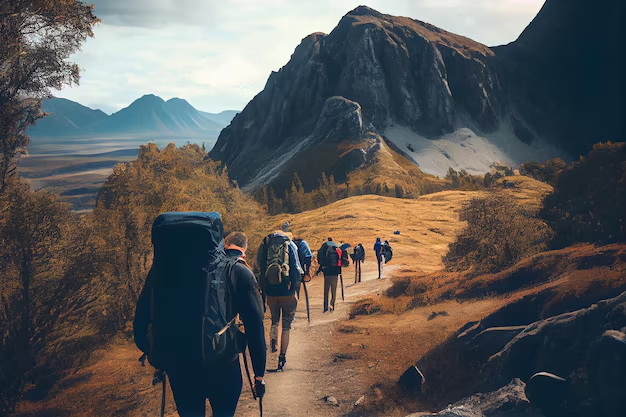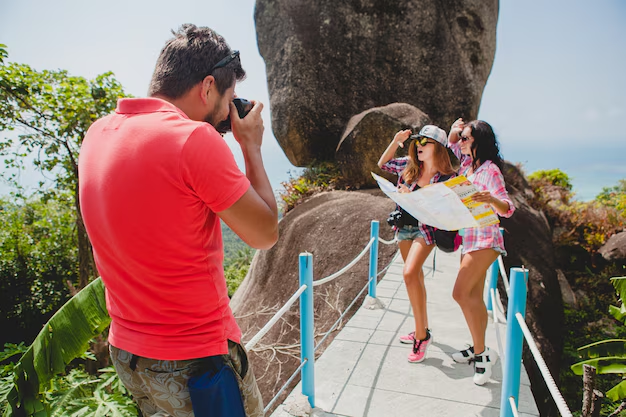In the last few decades, tourism has experienced a significant shift in focus, evolving beyond traditional beach vacations and luxury cruises to more adrenaline-pumping, thrill-seeking adventures. Adventure tourism is a rising trend that is reshaping how people explore the world. It combines the excitement of outdoor activities with the allure of travel, offering an immersive experience that allows individuals to test their limits and engage with the natural world in ways that conventional tourism cannot provide.
From climbing mountains to trekking through dense jungles, and from white-water rafting to bungee jumping, adventure tourism has grown rapidly, fueled by the search for unique and meaningful experiences. This article explores how adventure tourism is reshaping travel, offering a deeper connection to destinations, creating new economic opportunities, and fostering a growing sense of global community.
Key Takeaway
Adventure tourism is more than just a trend; it’s a transformative way of traveling that offers exciting, immersive experiences that challenge both body and mind. As it continues to grow, the focus will be on sustainability, safety, and the continued use of technology to enhance travel experiences. For both travelers and the communities they visit, adventure tourism holds the potential to create lasting positive impacts, reshaping the future of travel.
What is Adventure Tourism?
Adventure tourism can be defined as a type of tourism that involves exploration or travel to remote, exotic, or wilderness locations, where the traveler participates in physically challenging or adrenaline-inducing activities. Unlike conventional forms of tourism, adventure tourism focuses on active participation and engagement rather than passive sightseeing.
Adventure tourists typically seek activities that push their physical or mental boundaries, such as hiking, rock climbing, diving, skiing, or safaris. These activities take place in natural environments, where travelers interact with landscapes, wildlife, and ecosystems in a more intimate way.
The Rise of Adventure Tourism
Shifting Travel Preferences
In recent years, tourists have been increasingly looking for experiences that offer more than just relaxation. This shift can be attributed to several factors:
- Desire for Unique Experiences: Travelers today are looking for something beyond typical tourist attractions. They seek experiences that are authentic and immersive, allowing them to connect with local cultures and nature in meaningful ways.
- Social Media Influence: Platforms like Instagram and YouTube have played a pivotal role in showcasing breathtaking destinations and heart-racing adventures. Travelers now seek to recreate the experiences they see online, contributing to the surge in popularity of adventure tourism.
- Personal Growth and Empowerment: Many travelers are motivated by the idea of challenging themselves and growing through physical and mental challenges. Activities such as mountain trekking or skydiving provide a sense of accomplishment that traditional vacations cannot match.
Accessibility of Adventure Activities
In the past, adventure tourism was often perceived as something reserved for elite or highly experienced travelers. However, with advancements in technology and improved infrastructure, adventure activities are becoming more accessible to people of all skill levels. Guided tours, professional instructors, and safety measures have made activities such as rock climbing, bungee jumping, and scuba diving available to a wider audience.
Additionally, adventure tourism destinations have become increasingly accessible with the development of transportation systems and better global connectivity. From remote mountain ranges to tropical rainforests, previously hard-to-reach locations are now more navigable for those seeking an adrenaline rush.
How Adventure Tourism is Shaping Travel Experiences
Connecting with Nature
One of the defining characteristics of adventure tourism is the deep connection it fosters with nature. Whether it’s hiking through the wilderness, trekking up a snow-capped peak, or diving into the depths of the ocean, adventure tourism takes travelers into the heart of natural environments, offering them an opportunity to experience landscapes and wildlife in ways that other forms of tourism cannot.
For many, this connection with nature is transformative, leaving them with lasting memories and a greater appreciation for environmental conservation. In fact, many adventure tourists actively seek destinations known for their natural beauty and untouched landscapes, such as the Amazon rainforest, the Himalayas, or the Great Barrier Reef.
Cultural Exchange and Learning
Adventure tourism also plays an important role in cultural exchange. Many adventure tourists venture to destinations that offer a rich cultural heritage and unique traditions. Whether it’s visiting remote villages in Africa, trekking through the Inca Trail in Peru, or engaging with indigenous cultures in Australia, these experiences provide valuable insights into local ways of life.
Adventure tourism offers more than just the opportunity to view cultures; it allows for immersive engagement, where travelers can learn firsthand about local traditions, customs, and histories. The interactions between travelers and local communities foster mutual respect and understanding, contributing to a more meaningful and educational travel experience.
Economic Opportunities for Local Communities
Adventure tourism has proven to be an important economic driver for many local communities. By promoting destinations that are off the beaten path, adventure tourism encourages the development of local businesses, including tour operators, guides, hotels, and restaurants. This helps to create job opportunities in regions that might otherwise struggle with limited economic activity.
For instance, in regions like the Himalayas, where trekking and mountaineering are popular activities, adventure tourism has enabled local communities to thrive by providing jobs as guides, cooks, porters, and innkeepers. Similarly, in places like Costa Rica, ecotourism and adventure tourism have been instrumental in supporting the local economy while encouraging sustainable practices.
Fostering Sustainability
Sustainability is a major concern for modern travelers, and adventure tourism has a unique ability to promote environmental consciousness. Adventure travelers are often drawn to destinations known for their pristine natural beauty, and as such, many are more inclined to engage in responsible travel practices that minimize their environmental impact.
By choosing eco-friendly activities such as hiking, kayaking, or wildlife safaris, adventure tourists help support sustainable tourism practices that prioritize conservation. Additionally, many adventure tourism companies are adopting responsible practices by ensuring that their activities have minimal environmental impact and that they contribute to local conservation efforts.
Adventure Tourism: Thriving with Technology and Innovation
Advances in technology and innovation have also played a significant role in the growth of adventure tourism. Innovations in equipment, safety measures, and online booking platforms have made it easier for tourists to engage in activities and plan their trips.
For example, improvements in hiking gear, scuba diving equipment, and even technology like drones for aerial photography have made adventure activities more accessible and enjoyable. Online booking platforms have simplified the process of booking adventure tours, allowing travelers to quickly access a range of adventure travel options and compare prices.
Moreover, advancements in virtual and augmented reality (VR/AR) are opening new possibilities for adventure tourism. Travelers can experience activities like hiking, mountaineering, and even extreme sports from the comfort of their homes through VR simulations, sparking interest and inspiring real-life adventure trips.
Challenges and Considerations in Adventure Tourism
While adventure tourism offers numerous benefits, it also comes with its challenges. One of the primary concerns is the potential environmental impact of tourism in sensitive ecosystems. As more travelers flock to natural destinations, there is a risk of overcrowding and damage to fragile environments, such as coral reefs, forests, and mountain trails.
Additionally, safety is a crucial issue in adventure tourism. The inherent risks involved in activities like skydiving, white-water rafting, and rock climbing mean that proper training, safety protocols, and equipment are essential for ensuring the well-being of tourists.
To mitigate these risks, many adventure tourism companies are working closely with local governments and conservation organizations to implement sustainable tourism practices that protect the environment and ensure the safety of travelers.
The Impact of Adventure Tourism on Destinations and Culture
Adventure tourism is a rapidly growing sector that has significantly transformed the landscape of global travel. By encouraging travelers to immerse themselves in nature and engage in thrilling, physically demanding activities, adventure tourism is reshaping not only the travel industry but also the destinations and cultures it touches. As more people seek experiences that challenge their limits and connect them to the natural world, the impact on local communities, cultures, and environments becomes increasingly significant. In this article, we will explore how adventure tourism affects destinations and cultures, highlighting both the positive and negative consequences of this growing trend.
What is Adventure Tourism?
Adventure tourism involves traveling to natural or remote destinations with the intention of engaging in activities that offer physical or mental challenges. These activities include hiking, mountaineering, bungee jumping, rock climbing, scuba diving, kayaking, trekking, and safaris. Adventure tourism goes beyond simply sightseeing; it is about actively participating in and immersing oneself in the environment.
This form of tourism is often characterized by its focus on the outdoors and nature. It appeals to travelers looking for a more authentic, hands-on experience, where they can interact with the environment in a deeper, more meaningful way. Destinations typically include mountains, jungles, deserts, oceans, and other natural landscapes.
The Rise of Adventure Tourism
Adventure tourism has seen exponential growth in recent years. With the increasing desire for authentic and off-the-beaten-path travel experiences, more travelers are seeking activities that push them out of their comfort zones. Several factors have contributed to this growth:
- Social Media Influence: Platforms like Instagram and YouTube have amplified the appeal of adventure tourism by showcasing stunning images and videos of remote destinations and extreme activities. The “Instagrammable” nature of adventure travel has attracted millions of new tourists to previously underexplored regions.
- Desire for Unique Experiences: Travelers are increasingly seeking experiences that differ from the typical luxury vacation. Adventure tourism offers a chance for self-discovery, personal growth, and the creation of lasting memories through unique, often life-changing activities.
- Access to Remote Destinations: Advancements in travel technology and infrastructure, including budget airlines, improved roads, and easier access to remote areas, have made it easier for travelers to visit places that were once hard to reach.
- Health and Wellness Trends: The rise of fitness and wellness culture has also contributed to the boom in adventure tourism. Activities such as hiking, cycling, and kayaking not only provide excitement but also promote physical health and well-being.
Impact on Destinations
Adventure tourism is having profound effects on the destinations where it thrives. While there are many positive impacts, such as economic benefits and increased global exposure, there are also negative consequences that must be considered.
Economic Growth and Job Creation

One of the most significant benefits of adventure tourism for destinations is the economic boost it provides. Adventure tourists tend to spend money not only on accommodations and flights but also on local services such as guides, transportation, equipment rentals, and meals. In areas with limited economic activity, adventure tourism can provide much-needed revenue and create job opportunities.
For example, in countries like Nepal, where trekking is a major tourist activity, the industry has created jobs for thousands of locals as porters, guides, cooks, and accommodation providers. Similarly, in countries like Costa Rica, the booming adventure tourism sector has supported eco-tourism businesses that provide jobs in conservation and wildlife protection.
Moreover, the economic influx from adventure tourists can help support local businesses and improve infrastructure, leading to further development in these areas. This can lead to improved roads, better healthcare, and even increased access to education and other public services.
Promotion of Sustainable Practices
Adventure tourism is closely linked to environmental conservation. Many adventure tourists are nature lovers who seek destinations with pristine ecosystems and natural beauty. As a result, they are often more conscious of their environmental impact and more likely to engage in sustainable travel practices.
In response, many adventure tourism companies focus on responsible travel, promoting eco-friendly activities that have minimal environmental impact. For example, trekking and hiking do not cause significant environmental degradation compared to mass tourism, and some adventure tourism businesses have embraced Leave No Trace principles, ensuring that their activities do not harm the natural surroundings.
Additionally, adventure tourism can raise awareness of conservation issues. Travelers who visit sensitive ecosystems, such as rainforests, coral reefs, and mountain ranges, often become advocates for their protection. Through their travels, these tourists can help promote environmental education and inspire positive change in local communities and on a global scale.
Pressure on Local Resources
However, the rise of adventure tourism can also put significant strain on local resources. As the number of tourists increases, there can be increased demand for water, energy, food, and waste disposal services. Small, remote communities may struggle to accommodate these needs, leading to overburdened infrastructure and environmental stress.
In popular adventure destinations, overcrowding can become an issue, especially during peak seasons. In places like Mount Everest, popular trekking routes have become overrun with tourists, leading to overcrowding and trash accumulation. The increased foot traffic can damage fragile ecosystems, contribute to soil erosion, and harm wildlife habitats.
Local communities may also face rising costs of living as demand for goods and services increases. Property prices may rise, and the cost of everyday items can skyrocket, making it harder for locals to afford basic necessities.
Cultural Exchange and Awareness

Adventure tourism also fosters cultural exchange, as many adventure travelers seek to engage with local communities and learn about their way of life. Activities such as visiting indigenous villages, experiencing traditional cooking, and participating in cultural festivals provide tourists with a deeper understanding of the local culture and history.
For local communities, this interaction can help preserve cultural traditions and raise awareness about their heritage. Adventure tourists often respect and appreciate local customs and may choose to spend their money supporting local artisans, guides, and community-based businesses. This can provide an incentive for locals to maintain their cultural practices and protect their heritage.
The Risk of Cultural Erosion
On the other hand, adventure tourism can sometimes lead to the erosion of local cultures. The influx of tourists from different countries, each with their own expectations and behaviors, can result in the commercialization of local customs and traditions. For example, indigenous practices may be altered to cater to the demands of tourists, leading to a dilution of authenticity.
In some cases, adventure tourism can also bring unwelcome outside influences, such as the spread of consumerism, Western values, or behaviors that are in conflict with traditional ways of life. Locals may feel pressure to alter their lifestyles to accommodate tourist expectations, potentially leading to cultural homogenization.
The Role of Responsible Adventure Tourism

As adventure tourism continues to grow, it is essential that both travelers and businesses embrace responsible tourism practices. This involves understanding the environmental, social, and cultural impacts of their activities and making efforts to minimize negative effects.
Supporting Local Communities
Adventure tourists should seek out experiences that directly benefit local communities, choosing to book tours and activities that are run by local operators and contribute to local economies. This supports small businesses and ensures that tourism dollars stay within the region.
Adopting Sustainable Practices
Both tourists and operators should prioritize sustainability. Adventure tourists can make a conscious effort to reduce their environmental footprint by following established guidelines and using eco-friendly products. Operators can minimize their environmental impact by implementing practices such as waste reduction, wildlife protection, and promoting responsible tourism education.
Respecting Local Cultures
Respecting local cultures is vital to preserving the authenticity of destinations. Adventure tourists should approach cultural exchanges with respect, take the time to learn about local customs, and avoid behaviors that may offend or disrupt the local way of life. By engaging in responsible cultural tourism, travelers can contribute to the preservation of traditional practices and support the local identity.
Conclusion
Adventure tourism has evolved into one of the most dynamic and fast-growing sectors in the travel industry. With its emphasis on unique experiences, cultural immersion, and connection to nature, adventure tourism is reshaping the way people travel, offering more personalized and meaningful journeys. As the world continues to explore new horizons, adventure tourism will continue to foster global awareness, sustainability, and economic growth, while providing travelers with unparalleled experiences and memories.
FAQs
What is adventure tourism?
Adventure tourism involves traveling to remote or natural locations to engage in physically demanding activities such as trekking, rock climbing, diving, or safaris.
How does adventure tourism benefit local communities?
Adventure tourism creates economic opportunities by supporting local businesses like tour operators, guides, and accommodations, helping to boost the local economy.
Is adventure tourism safe?
While adventure tourism can involve risks, most tour operators follow strict safety protocols and provide the necessary equipment and training to minimize those risks.
What are some popular adventure tourism destinations?
Popular destinations include the Himalayas, Costa Rica, New Zealand, Patagonia, and Africa’s Serengeti for safaris.
How can I get started with adventure tourism?
Starting with adventure tourism involves choosing activities that match your fitness level and interests, as well as booking through reputable companies that provide safety and training.
How does adventure tourism promote sustainability?
Adventure tourism promotes sustainability by encouraging eco-friendly activities and raising awareness about conservation and responsible travel practices.
What are the environmental concerns associated with adventure tourism?
Adventure tourism can lead to overcrowding, habitat destruction, and pollution if not managed properly, which is why responsible travel practices are essential.




